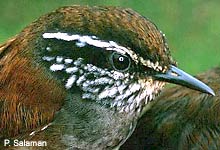Munchique Wood-wren Henicorhina negreti CRITICALLY ENDANGERED

Munchique Wood-wren
A typical wood-wren. Sexes are similar, dark brown on the crown with warmer brown upperparts, short wings and tail are lighter warm brown barred with darker barring, prominent white supercilium above black eyestripe and ear coverts streaked white, throat white, chest pale grey, flanks, vent and undertail coverts chestnut, finely barred on the abdomen.
Similar spp very similar to Grey-breasted Wood-wren H. leucophrys, best features to aid separation are barred abdomen and cooler grey upperparts in Munchiques Wood-wren. It also has longer tarsi and a shorter tail than Grey-breasted. Voice is distinctive. Voice repeated phrases of 6-12 clear notes, each phrase lasting c. 2 seconds. Henicorhina negreti is restricted to a tiny range in the western Andes of Colombia where the departments of Chocó, Antioquia and Risaralda meet; and in Munchique massif (Valle de Cauca). A Fundación ProAves monitoring team discovered a tiny population in extreme eastern Chocó and SW Antioquia department. It appears to have very specific habitat requirements, being restricted to the Pacific slope of the very peaks of the highest mountains/ridges on the Western Cordillera. The Western Cordillera is the lowest and narrowest of Columbia’s three Andean ranges. As a result this species’s global area of occupancy is tiny. 5-8 territorial pairs or males were registered along a 2 km transect. This represents a much lower density than parapatric populations of H. leucophrys (c. 10-14 territorial pairs per 2 two km transect). The population density of 1 km2 may be as few as 10 pairs or as high as 16 pairs. Extrapolating the estimated population density to the Cauca and Antioquia areas of occupancy gives a global population between 180 pairs and 288 pairs based on the data available. This extremely small population is likely to be declining owing to ongoing forest clearance. Further declines in the future may be unavoidable if climatic conditions change. There have been many surveys of the high peaks along the Western Cordillera (both historically and in the past decade) that have failed to record this species, suggesting there are unlikely to be many undiscovered populations remaining. It is very specific in its habitat requirements, occurring in extremely wet, stunted cloud forest where it is common in naturally disturbed forest with patchy successional habitat, typically preferring an extremely dense understorey smothered in epiphytes at forest borders, landslides and along stream gullies. This forest is characterized by almost continuous cloud or fog cover. It has been recorded between 2,250 m and 2,640 m. It feeds on arthropods gleaned from near to the forest floor, typically below 2 m. It will associate briefly with multi-species flocks as they pass through its territory. Forest clearance affects this species directly, but it also leads to reduced cloud and fog cover and a general drying of the habitat. This allows congeners to colonise the areas where Munchique Wood-wrens currently occur in isolation. Global warming has the potential to shift the elevation at which H. negreti and H. leucophrys replace one another (presumably upwards with increasing temperature), potentially reducing the possible range of the species. Human pressure in Munchique is escalating. Consequently deforestation within Munchique national park, until recently essentially pristine, is now a serious issue and continues within the two protected areas which support this species. (Salaman, Paul, Paul Coopmans, Thomas M. Donegan, Mark Mulligan, Alex Cortés, Steven L. Hilty and Luis Alfonso Ortega (2003) A new species of wood-wren (Troglodytidae: Henicorhina) from the western Andes of Colombia Ornitologia Colombiana Vol. 1 pp.4-21). (birdlife.org)
download discovery article
|

